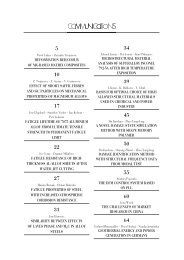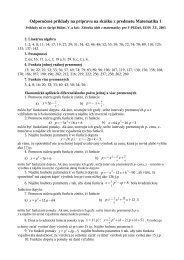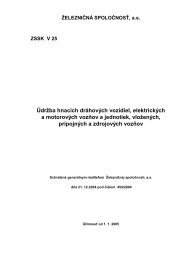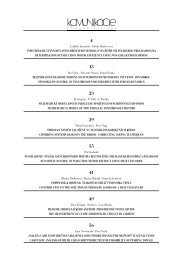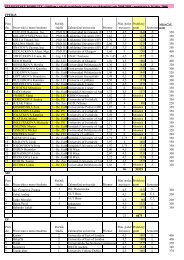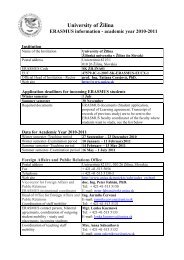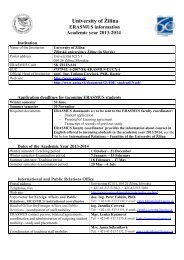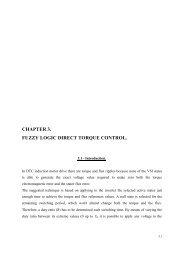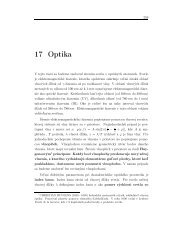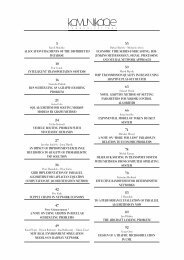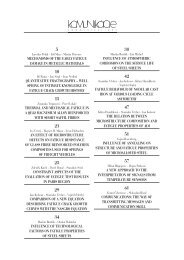simulation of torsion moment at the wheel set of the railway vehicle ...
simulation of torsion moment at the wheel set of the railway vehicle ...
simulation of torsion moment at the wheel set of the railway vehicle ...
Create successful ePaper yourself
Turn your PDF publications into a flip-book with our unique Google optimized e-Paper software.
REVIEWth<strong>at</strong> <strong>the</strong> GPS does not recognize <strong>the</strong> curve <strong>of</strong> <strong>the</strong> <strong>railway</strong> track in<strong>the</strong> <strong>moment</strong> <strong>of</strong> reading, but it works along <strong>the</strong> bee-line. Therefore<strong>the</strong> accuracy <strong>of</strong> this system amounts to approxim<strong>at</strong>ely 94 %. If <strong>the</strong>number <strong>of</strong> squares is increased, <strong>the</strong> squares become smaller anda more accur<strong>at</strong>e result is obtained.Fig. 11 Measuring <strong>of</strong> consumption <strong>of</strong> energy on electric locomotives onSlovene <strong>railway</strong>sand current transductor type LF 2005-S/SP9. The consumed energyis read by <strong>the</strong> d<strong>at</strong>a memory, in which <strong>the</strong> d<strong>at</strong>a on consumedenergy and d<strong>at</strong>a from GPS are combined. These d<strong>at</strong>a are sent to<strong>the</strong> server EGIDA (where <strong>the</strong> d<strong>at</strong>a <strong>of</strong> all electric locomotives arecollected). From <strong>the</strong>re <strong>the</strong> d<strong>at</strong>a are sent to <strong>the</strong> server GEMA.R,which unites all <strong>the</strong> d<strong>at</strong>a from <strong>the</strong> inform<strong>at</strong>ion system <strong>of</strong> trafficperformance (ISUP) and from <strong>railway</strong> subst<strong>at</strong>ions (ENP). Thed<strong>at</strong>a on <strong>the</strong> consumer are sent to <strong>the</strong> INTRANET [5].In <strong>the</strong> continu<strong>at</strong>ion, <strong>the</strong> analysis <strong>of</strong> <strong>the</strong> run <strong>of</strong> <strong>the</strong> train No.47408, with a mass <strong>of</strong> 1708 tons and with a locomotive series 363– 004 is shown for <strong>the</strong> trip from Ljubljana to Maribor on 14 September2007. For better understanding <strong>the</strong> analysis <strong>of</strong> energy consumption<strong>of</strong> this train is given only for <strong>the</strong> distance travelled fromLjubljana to Ljubljana Moste (Table 1) [6].Analysis <strong>of</strong> electricity consumption <strong>at</strong> train 47408on <strong>railway</strong> line Ljubljana – Ljubljana Moste Table 1Consumed[kWh]Regener<strong>at</strong>ed[kWh]TracksectionSpeed[km/h]Width[m]Length[m]1 0 Ljubljana 0 46.0588 14.52671 0 Ljubljana 0 46.0588 14.52670 0 Ljubljana 17 46.0588 14.527920 0 Ljubljana –LjubljanaMoste35 46.0589 14.5339The fifth and <strong>the</strong> sixth column in <strong>the</strong> table represent <strong>the</strong> widthand <strong>the</strong> length <strong>of</strong> d<strong>at</strong>a acquisition from <strong>the</strong> locomotive by <strong>the</strong>GPS equipment. The GPS system divides <strong>the</strong> area <strong>of</strong> movement<strong>of</strong> <strong>the</strong> locomotive into small squares and each such square indic<strong>at</strong>estransmitted inform<strong>at</strong>ion about <strong>the</strong> energy consumed from<strong>the</strong> locomotive to <strong>the</strong> centre. It must be taken into consider<strong>at</strong>ionOver <strong>the</strong> total distance <strong>of</strong> 156 km <strong>the</strong> electric energy consumptionfor this train was 2893 kWh. This energy consumption amountsonly to 10.89 Wh/brtkm which is much less than average consumption<strong>of</strong> 35.1 Wh/brtkm with 461 series locomotives. This isdue to differences in <strong>railway</strong> line difficulty. Line Ljubljana – Mariborhas no ascending slopes, for <strong>the</strong> most part <strong>the</strong>re is a downgrade <strong>of</strong>10 ‰. Lines <strong>of</strong> <strong>the</strong> Serbia <strong>railway</strong>s, for which <strong>the</strong>se measurementsare made, are mainly steep with a slope up to 27 ‰.Line Koper – Divaca in Slovenija with a slope up to 26 ‰energy consumption with 363 series locomotives amounts about45 Wh/brtkm.6. ConclusionThe s<strong>of</strong>tware for <strong>the</strong> electric locomotive optimiz<strong>at</strong>ion controlfor driving energy savings purposes enables <strong>the</strong> user to find <strong>the</strong>optimal combin<strong>at</strong>ion (according to his needs) <strong>of</strong> <strong>the</strong> changeabletrain traction parameters. Almost every train traction parameter ischangeable: locomotive series with all characteristic parameters(<strong>wheel</strong> usage percentage, rot<strong>at</strong>ion masses affect factor, nominaltraction motors voltage value, continuous and maximum tractionmotors current, efficiency <strong>of</strong> cog-<strong>wheel</strong>s, deform<strong>at</strong>ion factor, locomotiveactive and apparent power on <strong>the</strong> pantograph, etc.), lineelements (maximum speeds, stopping, restricted-speed running,length <strong>of</strong> stops in st<strong>at</strong>ions, track resistance, etc.). The amount <strong>of</strong><strong>the</strong> output results is bigger than in all <strong>the</strong> o<strong>the</strong>r projects done s<strong>of</strong>ar. The train running <strong>simul<strong>at</strong>ion</strong> time is considerably shorter thanin all o<strong>the</strong>r traction-energy calcul<strong>at</strong>ion methods known so far. The<strong>simul<strong>at</strong>ion</strong> results can also be used for making <strong>the</strong> regime card <strong>of</strong>each train run in <strong>the</strong> whole timetable diagram.In order to verify in practice <strong>the</strong> calcul<strong>at</strong>ed driving energy consumption<strong>of</strong> electric locomotives <strong>at</strong> <strong>the</strong> Serbian Railway numerousmeasurements are conducted on <strong>the</strong> tracks. These measurementsshow high coincidence between <strong>the</strong>oretical and practical results.The s<strong>of</strong>tware for train driving energy consumption is alsoapplied on <strong>the</strong> diesel locomotives and <strong>the</strong> only electric-motor trainseries ZS 412/416 for urban-suburban traffic on <strong>the</strong> Serbian Railways.For this manner <strong>of</strong> analysis <strong>of</strong> consumption electricity energyare decided in Slovenia because <strong>of</strong> larger number <strong>of</strong> carriers.COMMUNICATIONS 3/2008 ●55



